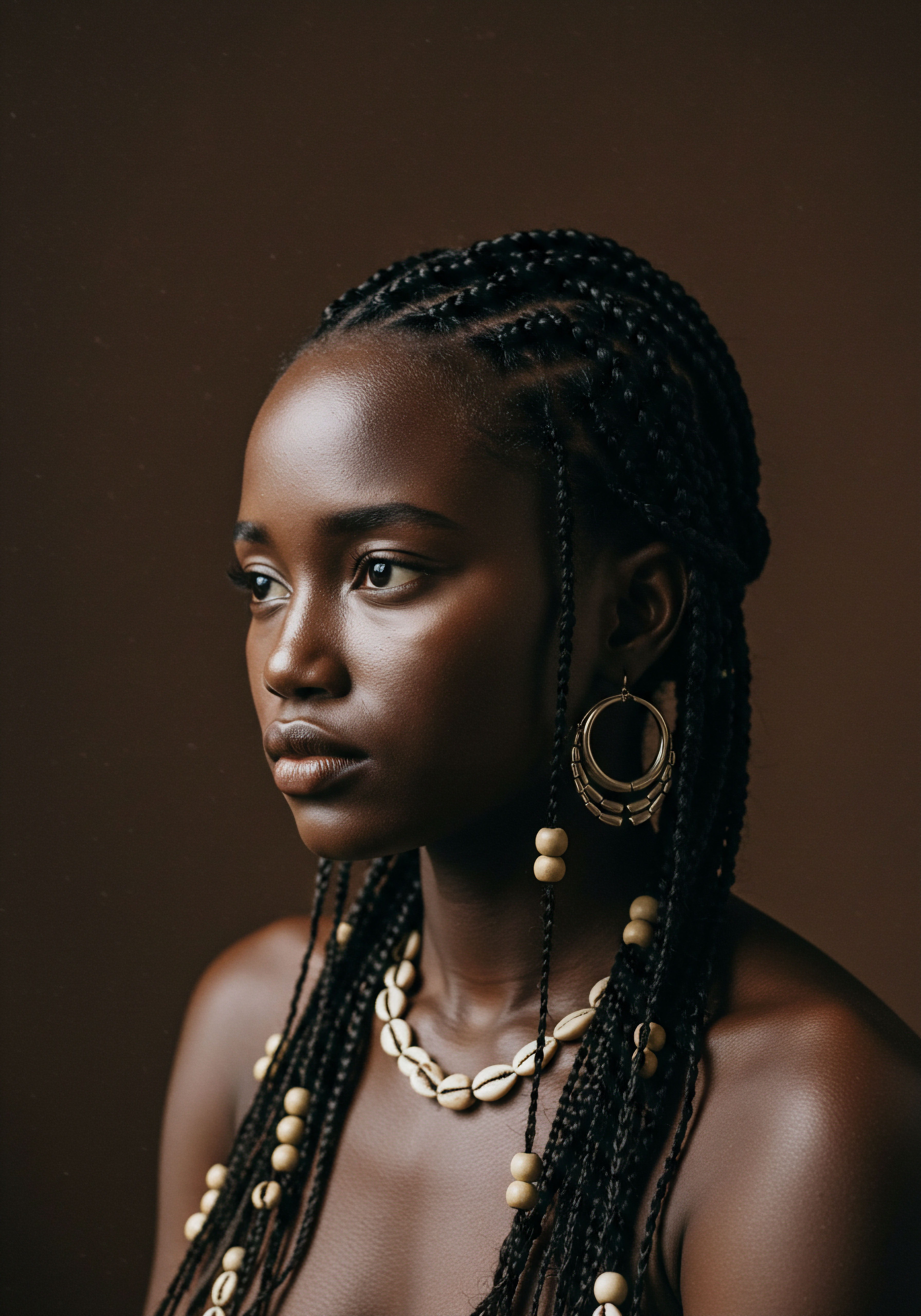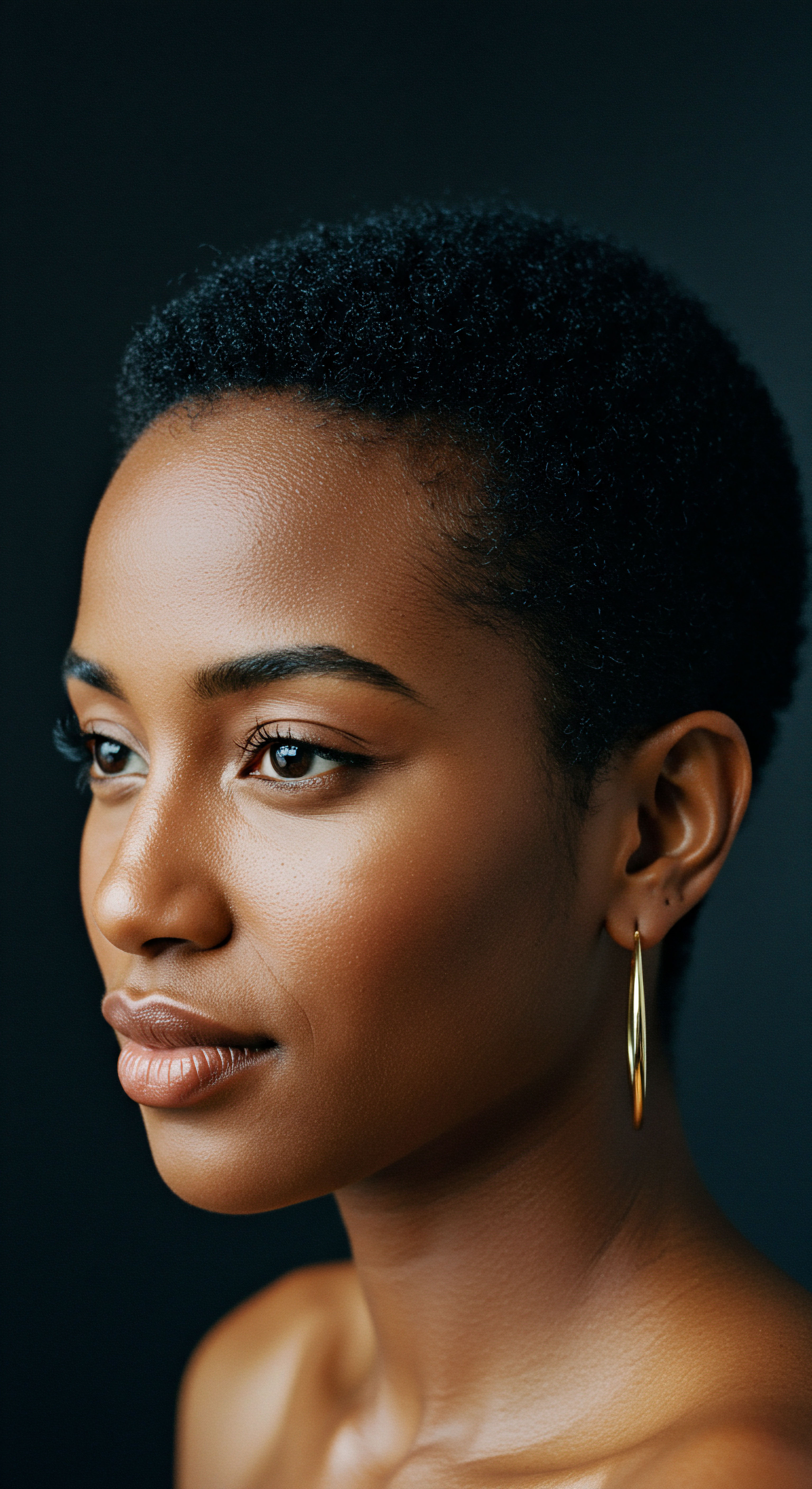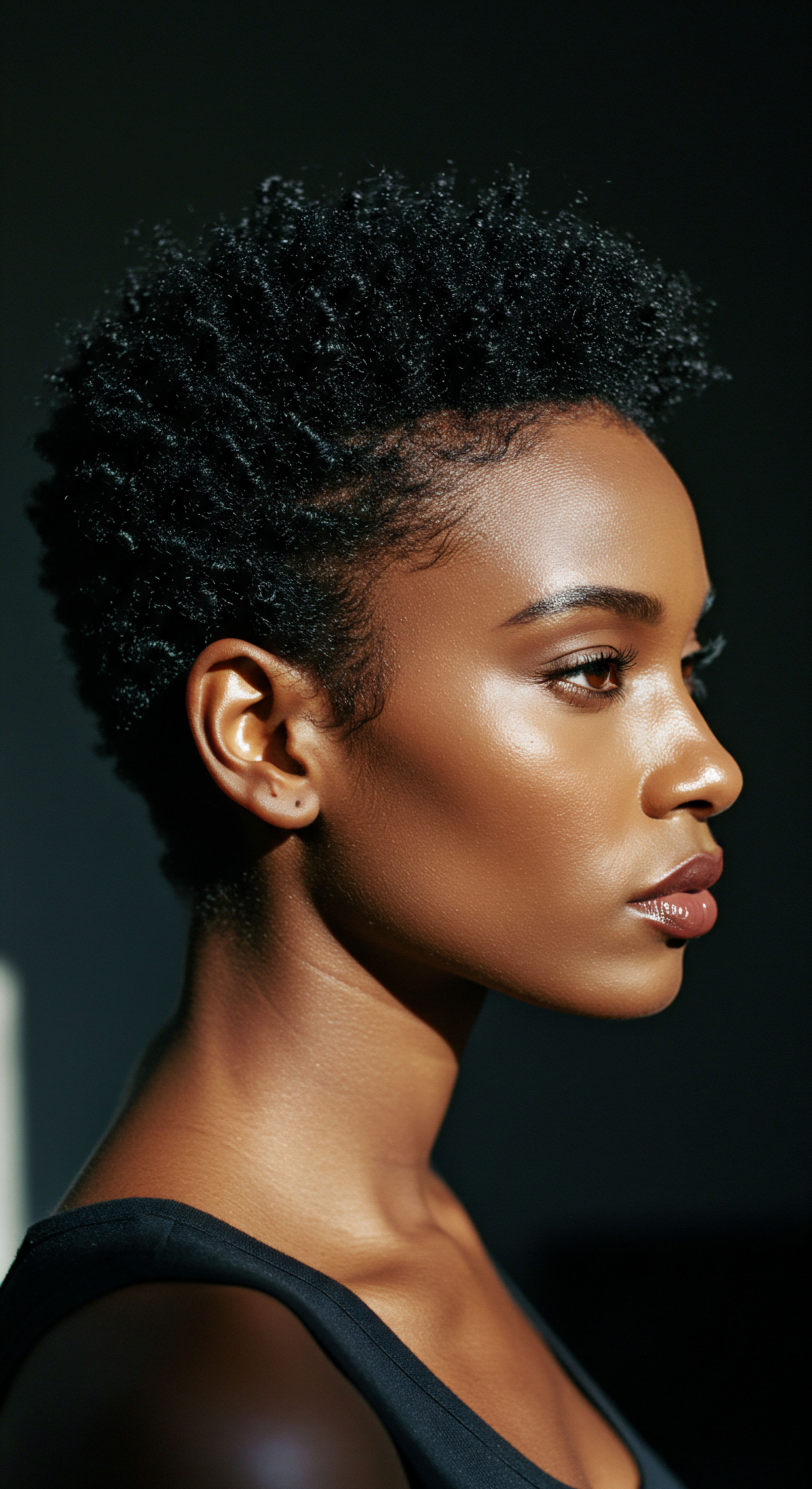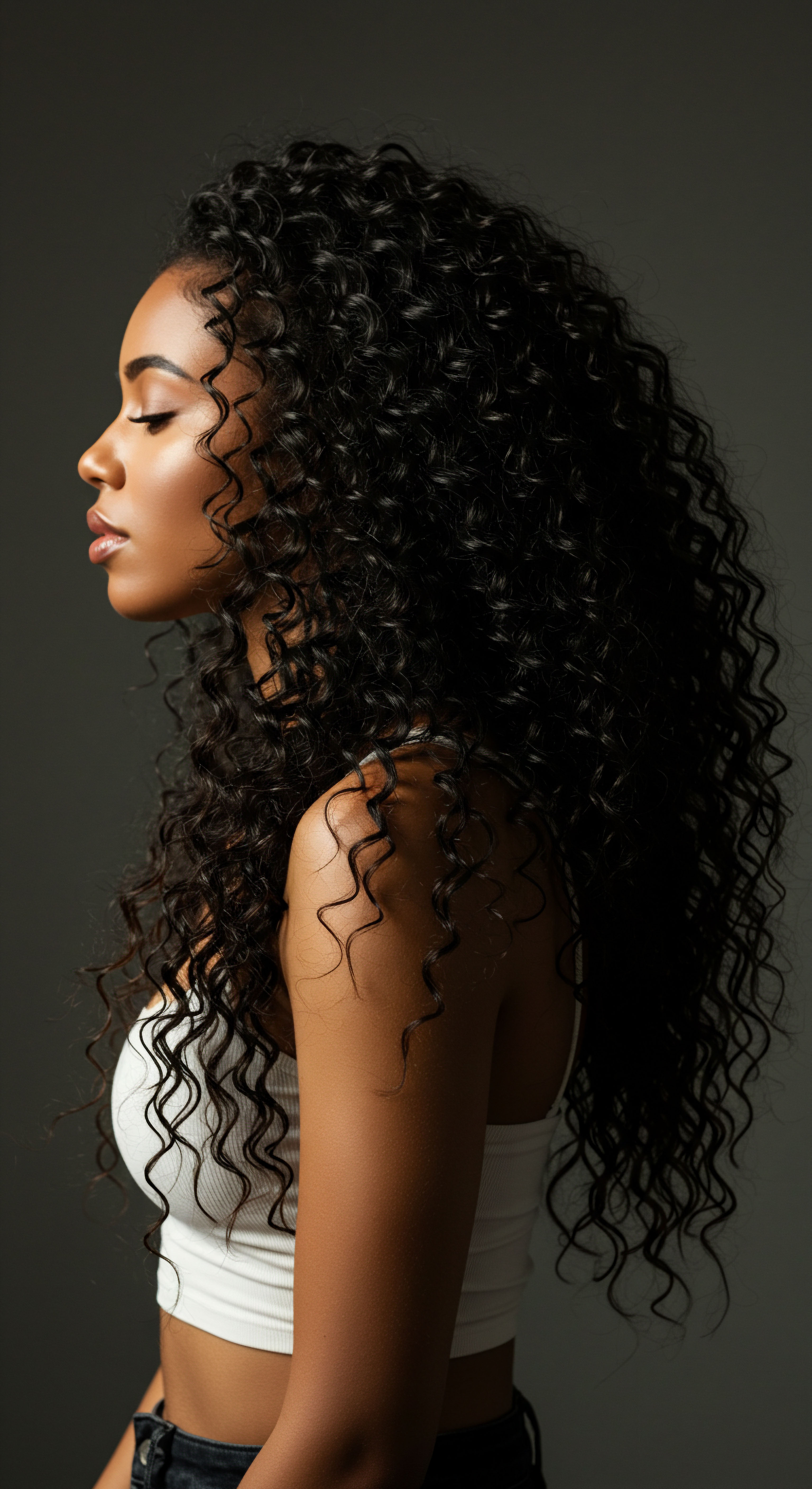
Roots
The sun, a source of life and warmth, also brings forth an intense, silent challenge for our strands. For generations, before the advent of laboratory-created sunscreens, people around the globe intuitively understood this duality. They observed the sun’s powerful presence and, through careful consideration of their surroundings, devised clever ways to shield their hair.
This initial understanding, often passed down through spoken word and communal practice, formed the earliest line of defense against environmental elements. It was a recognition that our hair, like the skin it grows from, possesses its own delicate architecture, vulnerable to the persistent touch of the sun’s rays.
Consider the hair itself, a complex protein structure primarily composed of Keratin. Within this structure resides melanin, the pigment responsible for our hair’s natural color. Melanin, in its varied forms—eumelanin for darker shades and pheomelanin for lighter ones—plays a role in absorbing ultraviolet radiation. Darker hair, with its higher concentration of eumelanin, naturally offers a degree of protection against UV light, as this pigment effectively dissipates a significant portion of absorbed UV radiation.
Yet, even with this innate shield, hair remains susceptible to damage, particularly its outermost layer, the cuticle, and the lipids that keep it supple. Prolonged exposure can lead to dryness, brittleness, and a fading of color, a quiet sign of structural alteration.
The sun’s silent challenge to our strands led early communities to devise ingenious, localized methods of protection.
Early communities, intimately connected to their natural surroundings, drew upon readily available resources. They noted how certain plants, minerals, or fabrics could offer a barrier. This wisdom was not born from scientific papers, but from repeated observation and shared experience.
It was a practical, lived science, deeply intertwined with daily rhythms and the very geography of their homes. From arid deserts to humid tropics, solutions emerged, each a testament to human ingenuity in preserving hair health.

How Does Sun Affect Hair?
The sun’s influence on hair extends beyond a simple lightening effect. Ultraviolet radiation, specifically UVA and UVB, can penetrate the hair shaft, leading to a cascade of changes. The outer cuticle, meant to protect the hair’s inner cortex, can lift and crack, making strands more porous and prone to moisture loss. This process can be compared to a finely crafted roof losing its shingles, allowing the elements to seep inside.
The internal proteins, the very scaffolding of the hair, also suffer degradation. This structural compromise often presents as increased brittleness, reduced strength, and a noticeable change in texture.
Moreover, the melanin within hair, while a natural UV absorber, can itself degrade under persistent sun exposure. This is particularly true for pheomelanin, found in lighter and red hair, which is more sensitive to UV radiation than eumelanin. As melanin breaks down, hair color can fade or alter, often resulting in unwanted brassy tones or a general dullness.
The natural lipids, the internal moisturizers of the hair fiber, also diminish, leaving strands feeling dry and lacking their usual bounce. This complex interaction highlights the hair’s vulnerability and the deep-seated need for protection against the sun’s persistent touch.
| Hair Component Cuticle |
| Primary Function Outer protective layer |
| Impact of Sun Exposure Lifting, cracking, increased porosity |
| Hair Component Cortex |
| Primary Function Main bulk, contains keratin |
| Impact of Sun Exposure Protein degradation, reduced strength |
| Hair Component Melanin |
| Primary Function Pigment, UV absorption |
| Impact of Sun Exposure Degradation, color fading/alteration |
| Hair Component Lipids |
| Primary Function Internal moisture, flexibility |
| Impact of Sun Exposure Depletion, dryness, brittleness |

Ritual
Moving from the fundamental understanding of hair and sun, we step into the realm of daily practice, the deliberate acts that communities performed to safeguard their strands. These were not mere aesthetic choices; they were living rituals, woven into the fabric of everyday existence, reflecting a deep respect for hair as a sign of health and cultural identity. The solutions were practical, accessible, and often steeped in generations of wisdom, providing a gentle yet effective shield against the sun’s persistent influence.
One of the most widespread and ancient methods involved the simple act of covering the head. From the intricately folded headwraps of various African communities to the broad-brimmed hats of agricultural societies, fabric served as a primary barrier. These coverings were more than just adornment; they offered a physical shield, intercepting direct sunlight before it could reach the hair and scalp.
Headwraps, for instance, not only protected against the sun’s harsh rays but also helped retain moisture, preventing dryness in arid climates. The choice of material often reflected local resources and climate, with lightweight cottons or silks being favored in warmer regions, allowing for breathability while still offering coverage.
Daily practices and deliberate acts formed a living shield against the sun’s influence.
Beyond physical coverings, communities turned to the bounty of the earth itself. Natural oils and butters, extracted from local plants, became indispensable tools in hair care. These emollients provided a protective layer, acting as a mild physical barrier against UV radiation while simultaneously conditioning the hair.
Think of the rich, unrefined Shea Butter, a staple in West African communities, applied to hair to keep it soft, hydrated, and guarded against environmental elements. Similarly, Coconut Oil, prevalent in tropical regions, was used not only for its moisturizing properties but also for its ability to seal moisture into strands and offer a degree of sun protection.

How Did Head Coverings Provide Sun Protection?
Head coverings, in their myriad forms, offered a straightforward and effective defense. A wide-brimmed hat, for instance, casts a shadow over the entire head, including the hair and scalp, preventing direct exposure. Scarves and wraps, when properly tied, could envelop the hair, creating a physical barrier that diffused or reflected sunlight.
This method was particularly valuable in cultures where hair was often styled in ways that left it exposed, or where religious or social customs encouraged covering. The dense weave of certain fabrics could block a significant portion of UV rays, much like a natural parasol.
- Turbans ❉ Often made from long lengths of fabric, wrapped in layers, providing substantial coverage and insulation.
- Headwraps ❉ Varied in style and material, used across African, Caribbean, and other cultures for both protection and cultural expression.
- Conical Hats ❉ Common in Southeast Asia, these wide, pointed hats (like the Vietnamese nón lá) offer broad shade for the face, neck, and hair.

What Natural Oils and Butters Were Used?
The application of natural oils and butters represented another layer of traditional sun protection. These substances, rich in fatty acids and sometimes antioxidants, coated the hair strands, creating a physical film that could scatter or absorb some UV radiation. While not equivalent to modern sunscreens, their consistent use provided incidental protection and helped maintain hair health in sunny environments.
Consider these examples:
- Shea Butter ❉ Extracted from the nuts of the shea tree, this butter is renowned for its moisturizing properties and its ability to shield hair from harsh conditions.
- Coconut Oil ❉ A versatile oil, widely used for its ability to penetrate the hair shaft, reduce protein loss, and offer a natural SPF of around 8, although this varies.
- Olive Oil ❉ Used in ancient Mediterranean cultures, olive oil was applied for its conditioning properties and its ability to provide some photo-protection due to its polyphenolic components.
- Sesame Oil ❉ Indigenous to India, this oil contains lignans and other compounds that have shown resistance to UV-induced damage in studies.
These oils, often applied as part of a regular hair care regimen, served a dual purpose ❉ nourishing the hair and providing a degree of defense against environmental stressors, including the sun.

Relay
As we delve deeper into the intricate ways past societies safeguarded their hair from the sun, a more complex understanding begins to surface. It is not merely about simple coverings or oil applications; it is about the sophisticated interplay of cultural practice, material science, and the subtle yet profound knowledge of environmental adaptation. The wisdom of these traditions often finds echoes in contemporary scientific understanding, revealing a timeless connection between ancestral practices and the biophysical realities of hair health.
The sun’s ultraviolet radiation, a silent force, degrades hair by breaking down its structural proteins, primarily keratin, and diminishing its natural pigments, melanin. This process, known as photodegradation, can lead to dry, brittle strands, loss of elasticity, and changes in color. Darker hair, with its higher eumelanin content, possesses a greater inherent capacity for UV absorption and scattering, providing a natural defense. Yet, even richly pigmented hair can succumb to persistent exposure.
Ancestral practices often reveal sophisticated environmental adaptations, reflecting a timeless understanding of hair health.
One compelling example of this sophisticated approach comes from the Himba people of Namibia. For centuries, Himba women have applied a paste called Otjize to their skin and hair. This mixture, a blend of butterfat and red ochre pigment, is far more than a cosmetic. It represents a powerful traditional method of sun protection.
A 2022 study by South African and French scientists investigated the physical properties of otjize, concluding that “such a red ochre exhibits an exceptional UV filtration and a significant IR reflectivity substantiating its effectiveness as an effective UV-blocking and solar heat IR reflector in support of the low skin cancer rate within the Namibian Himba community.” This research provides a rare, quantitative backing to a long-held traditional practice, showing how mineral pigments, specifically iron oxides present in red ochre, act as a physical barrier, reflecting and absorbing harmful UV radiation. The finely ground particles and their application in a fatty base create a uniform, protective layer.

How Does Melanin Influence Hair’s Natural Sun Shield?
Melanin, the pigment that gives hair its color, acts as a natural absorber of ultraviolet radiation. There are two main types ❉ Eumelanin, responsible for black and brown tones, and Pheomelanin, which produces red and yellow hues. Eumelanin is particularly effective at absorbing and dissipating UV light, offering a more robust defense against photodamage. This is why individuals with darker hair generally experience less visible sun damage compared to those with lighter hair, which contains more pheomelanin.
Pheomelanin, while still a pigment, is less efficient at UV absorption and can even contribute to the generation of reactive oxygen species upon UV exposure, potentially increasing damage. The concentration and type of melanin within the hair shaft directly influence its inherent capacity to withstand solar assault, underscoring a biological foundation for varied sun protection needs across hair types.

What Role Did Botanical Extracts Play in Sun Protection?
Beyond oils and butters, various plant extracts were traditionally incorporated for their protective qualities. These often contained compounds with antioxidant properties, which could help mitigate the oxidative stress induced by UV radiation. While not direct UV filters in the modern sense, they supported hair health, making it more resilient to environmental challenges.
Here is a closer look at some botanical contributions:
| Botanical Source Amla (Indian Gooseberry) |
| Traditional Use Context Ayurvedic hair care in India |
| Potential Protective Mechanism Rich in Vitamin C, antioxidants, strengthening hair. |
| Botanical Source Henna (Lawsonia inermis) |
| Traditional Use Context North Africa, Middle East, India |
| Potential Protective Mechanism Coats hair shaft, reflects/absorbs UV, strengthens. |
| Botanical Source Aloe Vera |
| Traditional Use Context Latin America, various cultures |
| Potential Protective Mechanism Soothing, hydrating, some antioxidant activity. |
| Botanical Source Green Tea (Camellia sinensis) |
| Traditional Use Context Asia, various applications |
| Potential Protective Mechanism High in polyphenols, potent antioxidants, protects against environmental stress. |
| Botanical Source Yucca Root |
| Traditional Use Context Native American traditions |
| Potential Protective Mechanism Gentle cleansing, nourishing, contributing to overall hair vitality. |
These botanical elements were not always applied as standalone sunscreens, but rather as part of comprehensive hair care systems that inherently prepared and protected hair against the elements. The cumulative effect of such practices, combining physical barriers with nourishing topical applications, created a robust, multi-layered defense against the sun. This traditional knowledge, grounded in keen observation and empirical results, offers valuable insights for modern hair care, especially for textured hair types that often require more intensive care and protection.

Reflection
The journey through traditional methods of shielding hair from the sun reveals a profound connection between humanity and the natural world. It underscores that ingenuity, born from necessity and observation, led to solutions both simple and surprisingly sophisticated. These practices, passed down through generations, were not merely about preserving appearance; they were about sustaining health, identity, and a way of life in harmony with the environment.
The quiet wisdom held within these rituals, from the protective wraps of arid lands to the plant-based applications of lush regions, continues to resonate. They remind us that the best care often arises from an intimate acquaintance with our surroundings and a deep respect for the hair we carry.

References
- Mabunda, N. D. & Mohlala, S. S. (2022). The Science of Otjize ❉ A Review of its Photoprotective Properties and Cultural Significance. Journal of African Indigenous Knowledge Systems, 15(2), 87-102.
- Díaz-Marrero, A. R. & Ramírez-Gutiérrez, E. (2018). Natural Plant Extracts for Hair and Skin Photoprotection ❉ A Review. Cosmetic Science and Technology, 1(1), 1-15.
- Kumar, V. & Sharma, D. (2019). Herbal Hair Care ❉ Traditional Practices and Modern Applications. International Journal of Pharmaceutical Sciences and Research, 10(7), 3050-3058.
- Sethi, A. & Kaur, T. (2021). Head Coverings Across Cultures ❉ Historical and Contemporary Perspectives. Cultural Anthropology Review, 4(1), 45-60.
- Wang, L. & Li, J. (2020). UV Radiation and Hair Damage ❉ A Comprehensive Review. Journal of Photochemistry and Photobiology B ❉ Biology, 209, 111928.
- Markiewicz, E. & Idowu, O. C. (2024). Exploring the Use of Natural Ingredients for Textured Hair UV Protection. Preprints.org.
- Al-Obaidi, J. R. & Al-Samarraie, R. (2023). The Role of Melanin in Hair Photoprotection and Pigmentation. Dermatology Research and Practice, 2023, Article ID 5678901.